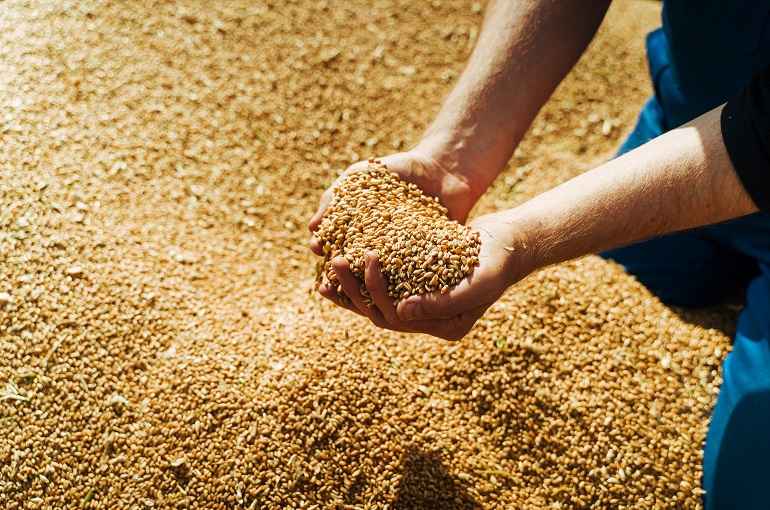Yield, Harvest, and Storage of Barley

This post is also available in:
This post is also available in:
![]() Español (Spanish)
Español (Spanish) ![]() Français (French)
Français (French) ![]() Deutsch (German)
Deutsch (German) ![]() Nederlands (Dutch)
Nederlands (Dutch) ![]() हिन्दी (Hindi)
हिन्दी (Hindi) ![]() العربية (Arabic)
العربية (Arabic) ![]() Türkçe (Turkish)
Türkçe (Turkish) ![]() 简体中文 (Chinese (Simplified))
简体中文 (Chinese (Simplified)) ![]() Ελληνικά (Greek)
Ελληνικά (Greek) ![]() Português (Portuguese (Brazil))
Português (Portuguese (Brazil)) ![]() polski (Polish)
polski (Polish)
What is the average yield per hectare of barley?
During the last five years, the average spring barley yield has been around 7.2 tons per hectare or 107.06 bushels per acre, while the average yield for winter barley is a little bit higher. About 10% of the spring barley goes for malting (1). Needless to say that these yield can be obtained by experienced growers in irrigated fields. In fields that rely only on rain, the yields can be about 50% to 60% of those mentioned above.
A critical developmental stage in barley that is believed to control adaptation to the environment and affect grain yield is the heading time. Of course, planting date and genetics also affect the final yield. As a result, a proper choice of adapted cultivars, planting dates, and fertilizer management, can help farmers optimize barley production while adjusting heading dates to periods with low risks of heat or frost. This way, the gap between the potential and actual yield can be reduced, which is the goal of every grower. Nitrogen management is the main factor that creates the gap between potential and actual yield (Cammarano et al., 2021).
When and how to harvest barley?
The three main factors that determine barley harvest time are the weather, the barley variety, and the maturity level of the plant. Generally, it is recommended to harvest when the moisture content is below 12%. However, if the grower harvests when the moisture content is above 12%, he/she has to apply aeration or pass the production through a grain dryer to succeed the desired moisture content for safe storage. When it comes to malting varieties, farmers usually harvest barley when its moisture is less than 18%. In other words, they proceed with harvesting when the plants have reached physiological maturity (dough stage) (2).
The most common machinery used is a combined harvester. Straight-cutting and swathing are the two standard barley harvesting methods.
How to properly store barley?
Before harvest, farmers have to choose between selling their products directly or storing them for a specific period. In the first scenario, the farmer should have already found a buyer (that is the case in contract farming), and he/she does not have to worry about over-drying or storage costs. However, in this case, since the product offer is relatively high, the prices that the barley can get are probably fairly low. By storing the product, the farmer has the opportunity to sell when the prices have reached a higher, more desirable level.
Every farmer knows that post-harvest handlings of every crop play an essential role in the final product’s quality. However, barley’s quality cannot be improved during storage. If the crop has been harvested and dried improperly, the quality will remain low no matter how well it is stored.
Below some crucial points regarding storage are mentioned (3):
- The first step for proper storage is, of course, the cleaning of bins and equipment. The remaining old grains may be contaminated with insects, which could be a source of a new infection. Fumigation is an effective way to clean areas that are difficult to get access. As a final step of the cleaning process, growers can apply an approved, residual-type insecticide.
- The barley storage temperature and the product’s moisture content are the two factors that will define the period of storage (4). Also, it is beneficial to have an aeration system to keep the product cool. Keep in mind that aeration is not a drying system and should not be used for this cause.
- Carry out regular checks of the stored product, monthly during cold weather and every two weeks during warm weather. Mold on the surface and in probe samples may exist.
References
- https://www.teagasc.ie/crops/crops/cereal–crops/spring–cereals/
- https://www.agric.wa.gov.au/barley/barley–production–harvest–and–grain–quality
- https://extension.umn.edu/small–grains–harvest–and–storage/storing–wheat–and–barley#use–aeration–to–cool–grain-1408664
- https://www.ag.ndsu.edu/graindrying/documents/Allowable%20Storage%20Time%20Cereals.pdf
- Cammarano, D., Ronga, D., Francia, E., Akar, T., Al-Yassin, A., Benbelkacem, A., Grando, S., Romagosa, I., Stanca, A. M., Pecchioni, N. (2021). Genetic and Management Effects on Barley Yield and Phenology in the Mediterranean Basin. Plant Sci. https://doi.org/10.3389/fpls.2021.655406
Barley History, Plant Information, and Nutritional Value
Principles for selecting the best Barley Variety
Barley Soil preparation, Soil requirements, and Seeding requirements
Barley Irrigation Requirements and Methods
Barley Fertilization Requirements and Methods
Yield, Harvest, and Storage of Barley








































































